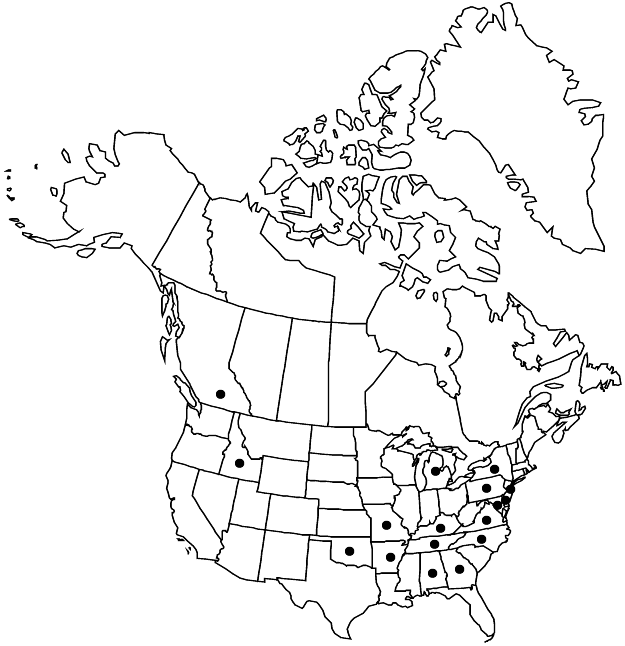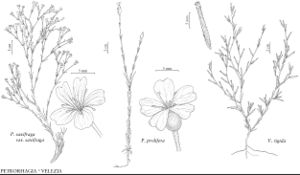Difference between revisions of "Petrorhagia prolifera"
Bull. Brit. Mus. (Nat. Hist.), Bot. 3: 161. 1964.
FNA>Volume Importer |
imported>Volume Importer |
||
| (One intermediate revision by one other user not shown) | |||
| Line 8: | Line 8: | ||
}} | }} | ||
|common_names=Proliferous or childing pink | |common_names=Proliferous or childing pink | ||
| + | |special_status={{Treatment/ID/Special_status | ||
| + | |code=I | ||
| + | |label=Introduced | ||
| + | }}{{Treatment/ID/Special_status | ||
| + | |code=F | ||
| + | |label=Illustrated | ||
| + | }} | ||
|basionyms={{Treatment/ID/Basionym | |basionyms={{Treatment/ID/Basionym | ||
|name=Dianthus prolifer | |name=Dianthus prolifer | ||
| Line 38: | Line 45: | ||
|elevation=0-1100 m | |elevation=0-1100 m | ||
|distribution=B.C.;Ala.;Ark.;Del.;Ga.;Idaho;Ky.;Md.;Mich.;Mo.;N.J.;N.Y.;N.C.;Okla.;Pa.;Tenn.;Va.;c;s Eurasia;introduced in Europe (Great Britain). | |distribution=B.C.;Ala.;Ark.;Del.;Ga.;Idaho;Ky.;Md.;Mich.;Mo.;N.J.;N.Y.;N.C.;Okla.;Pa.;Tenn.;Va.;c;s Eurasia;introduced in Europe (Great Britain). | ||
| + | |introduced=true | ||
|discussion=<p>Historical records for <i>Petrorhagia prolifera</i> exist also for California (1902; Congdon s.n., MIN), Ohio (last collected in 1896; Stair s.n., OS), and South Carolina (1800s; Durand s.n., NY).</p><!-- | |discussion=<p>Historical records for <i>Petrorhagia prolifera</i> exist also for California (1902; Congdon s.n., MIN), Ohio (last collected in 1896; Stair s.n., OS), and South Carolina (1800s; Durand s.n., NY).</p><!-- | ||
--><p><i>Petrorhagia prolifera</i> has been known in the northeastern United States since at least 1837, and its range has since expanded, with isolated populations occurring southwestward from New Jersey toward Arkansas and Oklahoma as well as western Michigan. Some introductions may have been as a contaminant in grass seed used for highway planting in Tennessee (B. E. Wofford et al. 1977). Literature reports of <i>P. prolifera</i> in Louisiana and West Virginia have not been confirmed.</p> | --><p><i>Petrorhagia prolifera</i> has been known in the northeastern United States since at least 1837, and its range has since expanded, with isolated populations occurring southwestward from New Jersey toward Arkansas and Oklahoma as well as western Michigan. Some introductions may have been as a contaminant in grass seed used for highway planting in Tennessee (B. E. Wofford et al. 1977). Literature reports of <i>P. prolifera</i> in Louisiana and West Virginia have not been confirmed.</p> | ||
| Line 62: | Line 70: | ||
|publication title=Bull. Brit. Mus. (Nat. Hist.), Bot. | |publication title=Bull. Brit. Mus. (Nat. Hist.), Bot. | ||
|publication year=1964 | |publication year=1964 | ||
| − | |special status= | + | |special status=Introduced;Illustrated |
| − | |source xml=https:// | + | |source xml=https://bitbucket.org/aafc-mbb/fna-data-curation/src/2e0870ddd59836b60bcf96646a41e87ea5a5943a/coarse_grained_fna_xml/V5/V5_336.xml |
|subfamily=Caryophyllaceae subfam. Caryophylloideae | |subfamily=Caryophyllaceae subfam. Caryophylloideae | ||
|genus=Petrorhagia | |genus=Petrorhagia | ||
Latest revision as of 22:10, 5 November 2020
Plants annual. Stems erect, simple or branched, (6–)20–30(–60) cm; internodes glabrous or midstem ones slightly scabrous. Leaves: sheath 1–2 mm, ± as long as wide; blade 3-veined, linear to linear-lanceolate, 10–30 mm, margins serrate-scabrous. Inflorescences capitate; inflorescence bracts and involucel bracteoles enclosing flowers, broadly ovate, brown-scarious, apex obtuse or of outer bracts mucronate. Pedicels 0.1–1.5 mm. Flowers: sepals (7–)10–12 mm; petals pink to slightly purplish (rarely white), primary veins 1, veins not darkly colored near base of blade, apex truncate or emarginate. Seeds shield-shaped, 1.1–1.6(–1.8) mm, fine to coarsely reticulate. 2n = 30 (Europe).
Phenology: Flowering summer.
Habitat: Roadsides, ballast, fields
Elevation: 0-1100 m
Distribution

Introduced; B.C., Ala., Ark., Del., Ga., Idaho, Ky., Md., Mich., Mo., N.J., N.Y., N.C., Okla., Pa., Tenn., Va., c, s Eurasia, introduced in Europe (Great Britain).
Discussion
Historical records for Petrorhagia prolifera exist also for California (1902; Congdon s.n., MIN), Ohio (last collected in 1896; Stair s.n., OS), and South Carolina (1800s; Durand s.n., NY).
Petrorhagia prolifera has been known in the northeastern United States since at least 1837, and its range has since expanded, with isolated populations occurring southwestward from New Jersey toward Arkansas and Oklahoma as well as western Michigan. Some introductions may have been as a contaminant in grass seed used for highway planting in Tennessee (B. E. Wofford et al. 1977). Literature reports of P. prolifera in Louisiana and West Virginia have not been confirmed.
Selected References
None.
